Leap Transit: to turn the bus into a combination of cafe, studio and bedroom
Follow the caf é (Wechat official account vdailycom) and found that Beautiful Cafe opened a small shop of its own.
There is a little simple information about Leap in China, but it is not comprehensive, and some information lags behind, such as price, operating time, operation status, and so on. The author referred to the official website of Leap, as well as foreign reports on it to form this article. As a new thing, there is still a lot of room for discussion on the topic of carpooling and chauffeured bus.
Now urban traffic congestion, coupled with the introduction of license plate restrictions and traffic restrictions, ride-sharing business has emerged one after another, and new companies emerge in endlessly. The chauffeured bus is getting hotter and hotter after the car. PP bus and easy access bus in Beijing, Xiaozhu bus and Zhongjiao Wansheng in Shenzhen, and Ta Da bus, which just received 5 million yuan in angel round and 37 million yuan in A round financing in mid-May, including new start-ups and established companies with hardware foundation.
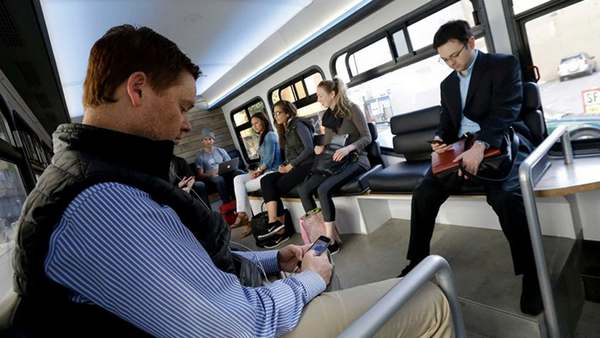
The annoyance of traffic jams is not unique to China. In a densely populated area like San Francisco in the United States, how to commute easily is also a difficult problem for office workers.
In the American market, ride-sharing services are just as hot: startup Loup, YC-funded Chariot, Lyft … And, of course, Uber. In San Francisco, the average price of a bus is $2.25. According to conventional thinking, the price of a chauffeured bus as an aid to the public transportation system should not float too much on this basis, exceeding customers' psychological expectations. One startup doesn't seem to think so, announcing a price of $6, nearly twice as high-- a startup called Leap Transit (Leap).
The Leap bus on the road is marked by a running puppy
Leap's CEO Kyle Kirchhoff grew up in Silicon Valley and his father worked for Hewlett-Packard. He experimented with the chauffeured bus model in San Francisco as early as May 2013, but soon suspended it until he made a comeback in 2014 after a change in operating thinking. It is worth noting that Leap currently has only one line running back and forth between Lombard Street and downtown, and does not seem to be in a hurry to expand its territory.
CEO Kyle Kirchhoff of Leap Transit
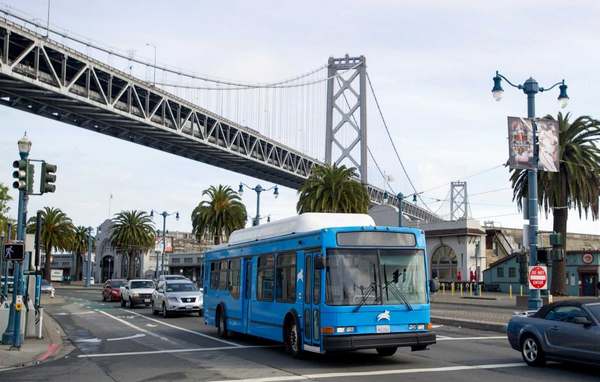
"unorthodox" Leap Transit
Also in the early days of the industry, compared with the domestic ride-sharing market trying to win the market with low prices and wide lines, the high pricing and single line of Leap seems puzzling. But after careful study, the author thinks that the innovative idea of Leap, which further subdivides the market and focuses on user experience, is worthy of reference by domestic chauffeured car companies. To sum up, there are mainly a few bright spots:
Market segmentation
Chauffeured buses serve people who are not willing to waste too much time on the public transport system. And Leap subdivided from this group of people who are "willing to save time, want to spend extra money to get a more comfortable feeling"-Leap, in addition to the high price, even the cold-pressed juice in the car costs as much as $7 a bottle.
Break the traditional layout of carriages
The Leap bus is divided into three areas: long strip tables on the side for mobile office; ordinary seats in the front row similar to cafe seats; and U-shaped card seats in the back row for groups that need to talk or people who like to socialize.
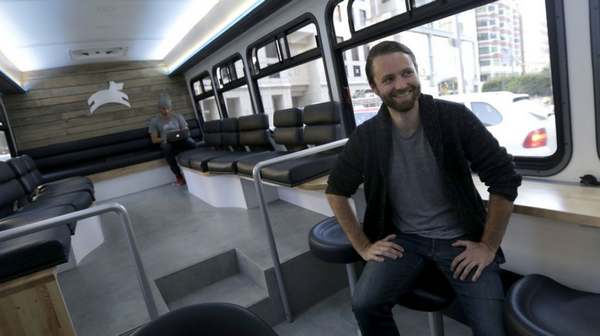
Leap's carriage layout is innovative and simple.
Carry out the O2O to the end
Passengers use their smartphones to scan the QR code at the scanner-if the phone comes with Bluetooth, they can also check tickets automatically without manual operation, while passengers who adhere to the traditional use of non-smart phones need to print out their tickets in advance.
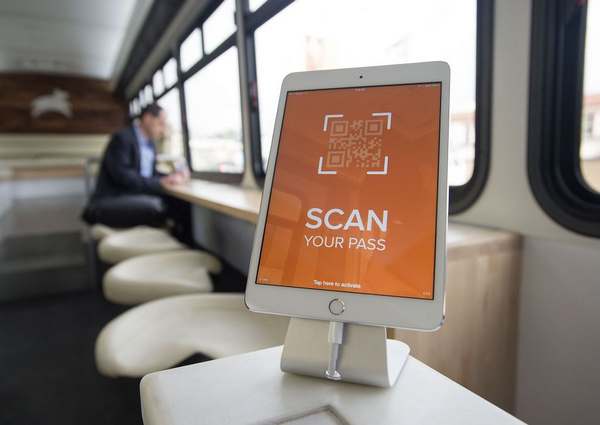
QR Code Scanner on Leap
Provide value-added services
The promotion of "one seat per person" for domestic chauffeured buses has satisfied us who are used to standing on the subway without trembling for an hour or two, but Leap is no doubt thinking more about turning the bus into a combination of cafe, studio and bedroom.
Each Leap bus has a mini-bar that provides convenient foods such as biscuits, yogurt, juice, coffee and so on. Sit in your seat and buy directly with App, and the waiter will deliver it to your seat. Leap said on its website that all food is preferred from local suppliers and is healthy organic food.
In addition, the USB port and free Wi-Fi are also standard for every bus, with long tables by the window to form a mobile office area.
The wooden strip table on the side is just right for the notebook.
A corner of food behind the bar
Standard waiter for chauffeured car
There is a special waiter on each Leap bus who wears a uniform for identification; he is responsible for guiding code scanning, controlling the temperature inside the bus, selecting music, delivering food, and so on. This also follows Kirchhoff's concept of "cafe + bedroom + studio".
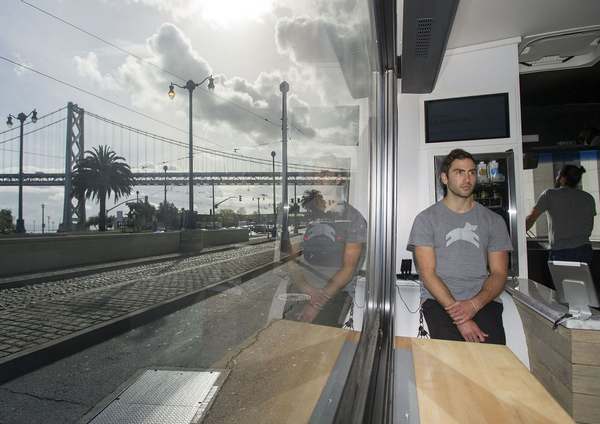
A Leap waiter in uniform
Real-time location tracking
Like the Kumi bus in Shenzhen, passengers can check the bus's location and estimated arrival time in real time from Leap's App, and leave on time, saving valuable morning time.
Take environmental protection as a selling point
Americans generally have a strong awareness of environmental protection, so Leap also takes it as a bright spot in its publicity. According to officials, the tables and chairs in the car are made of recycled wood, while the driving energy is clean natural gas.
Integrate into sociality
If social networking and interaction are the essence of the Internet, then Leap captures that. Unlike unfamiliar social contacts like shaking, it's good to know one or two friends with similar routes-to keep each other informed of the bus's latest developments, to share with each other about new and interesting shops near where you live, and even to find potential new owners.
On Leap App, users can choose to share their personal information appropriately and have the opportunity to know the relevant information about the passengers around them.
Leap buses operate from 6:30 to 10:00 and from 4:30 to 7:30 every 10-15 minutes, with a total journey of about 25 minutes. The ticket price is $6 (if you book 20 times at once, you will get a discount of $1 each time).
People in San Francisco have mixed comments on Leap, and some doubt whether it is against the original intention of the emergence of chauffeured buses, and it does not bring convenience to the maximum number of travelers while occupying road and parking resources. But from the perspective of exposure and profit, Leap is undoubtedly a success.
"if we charge $2, there will have to be more people on the bus. In this way, the passenger experience is not good, this is not the ride experience we want to create. We do this because we are passionate about technology and passionate about how things work. " "if we focus on creating a different experience [with other buses], passengers should not want to get off this bus." Kirchhoff explains his idea of differentiation in this way.
Although completely learning from Leap may not be a great success in China, the idea of deeply subdividing the population and providing value-added services is common and can be used for reference.
The common dilemma of chauffeured buses
In late May, SFgate.com, a subwebsite of San Francisco Chronicle, reported that Leap was suspended because of illegal operations.
This is very similar to the reason why Wuhan customer Management Office halted the first batch of 10 GAC MOTOR electric vehicles that Uber (Uber) put into operation on May 31. Wuhan customer Management Office pointed out that the vehicles did not go through the operating procedures and were not qualified to engage in passenger transport services, and had issued a "rectification order" to them, requiring Uber to stop all business activities of these vehicles immediately, otherwise they would be regarded as illegal operating vehicles and be investigated and dealt with in accordance with Wuhan Urban passenger Taxi Management regulations and Wuhan Urban passenger Taxi Operation Management measures. And impose a maximum fine of 10,000 yuan.
According to Leap, they are already applying for relevant permits from local committees, but they are no doubt in defiance of the law before they are allowed to hit the road.
In fact, Leap suspended its service briefly as early as mid-May. The external caliber of Kirchhoff is "to make some minor adjustments" and "to carry out routine maintenance". A week later, Leap reopened and offered a time-limited $2 one-way offer so far.
In fact, in addition to being on the road without a permit, Leap also failed to comply with safety regulations, reporting to the local motor vehicle driver safety department and putting itself under surveillance. In addition, according to federal law, wheelchair accessible facilities must be provided on buses, while Leap's modification of the interior of the car is not qualified.
Leap could be fined $5000 or up to one year in prison for hitting the road without a license, SFgate.com reported.
Important Notice :
前街咖啡 FrontStreet Coffee has moved to new addredd:
FrontStreet Coffee Address: 315,Donghua East Road,GuangZhou
Tel:020 38364473
- Prev

How do students open a coffee shop with a monthly net profit of more than 10,000 yuan?
In a coffee shop at Jiangmen Wuyi University, Lian Ming, Tao Wanjun and Feng Jiewen are settling the day's turnover. They are college students at Wuyi University and partners in this coffee shop. After more than three months of operation, the monthly net profit of the coffee shop has been met by three young owners when they decorated a hotel for a long-distance couple, all of whom earned one part-time job before.
- Next
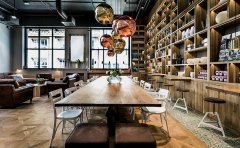
Appreciation of Decoration style of pano brot & kaffee Cafe in Germany
Dittel | architekten, a German architectural design company, designed the interior for pano brot kaffee. The store is located in the gerber Shopping Center, with a comfortable cafe environment and a solid oak table, which is 5m long and 1.15m wide. On the back wall is a bookcase of the same size and 5 meters high, displaying products of pano's own brand. There are about 92 seats. Phase
Related
- What documents do you need to go through to open a coffee shop? coffee shop coffee shop certificate processing process
- How to purchase Coffee beans in small Cafe how to choose a suitable supplier for domestic Coffee supply Company
- How to drink Starbucks Fragrance White Coffee? how to make Australian White Coffee? what Italian coffee beans are recommended?
- The Story of Flora Coffee: the name of Flora Coffee Bean and the implication of the Flowers on Florna Coffee
- How much does a cup of coffee cost? How much is the profit of a cup of coffee? What is the profit of the coffee shop in a year?
- Yunnan small Coffee, known as "fragrant Coffee", introduces the characteristics of Alpine Arabica Coffee producing areas in Yunnan, China
- 2023 latest Starbucks full menu price list how much is a cup of Starbucks coffee what is better to drink the most popular hot and cold drinks recommended
- Starbucks different kinds of Coffee Price list Starbucks menu 2023 Top Ten Best drinks in Starbucks
- Starbucks Spring praise Comprehensive matching Coffee Bean theme Story Packaging implication and taste description
- The cost of a cup of coffee latte American coffee cost price and selling price

